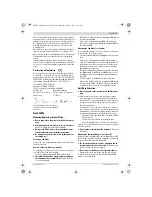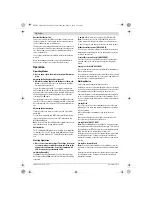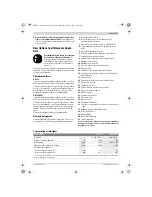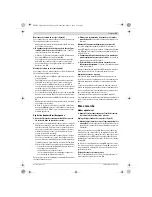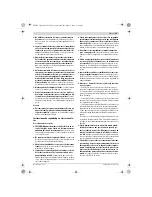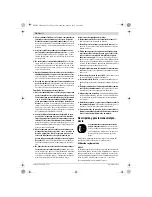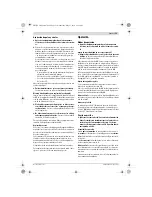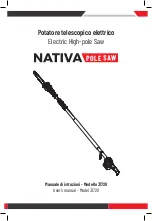
18
| English
2 609 932 939 | (21.5.14)
Bosch Power Tools
External Dust Extraction
Connect the vacuum hose
31
to a vacuum cleaner (accesso-
ry). An overview for connecting to various vacuum cleaners
can be found at the end of this manual.
The machine can be plugged directly into the receptacle of a
Bosch all-purpose vacuum cleaner with remote starting con-
trol. The vacuum cleaner starts automatically when the ma-
chine is switched on.
The vacuum cleaner must be suitable for the material being
worked.
When vacuuming dry dust that is especially detrimental to
health or carcinogenic, use a special vacuum cleaner.
Operation
Operating Modes
Before any work on the machine itself, pull the mains
plug.
Adjusting the Cutting Depth (see figure C)
Adjust the cutting depth to the thickness of the work-
piece.
Less than a full tooth of the blade teeth should be
visible below the workpiece.
Loosen the clamping lever
26
. For a smaller cutting depth,
pull the saw away from the base plate
15
; for a larger cutting
depth, push the saw toward the base plate
15
. Adjust the de-
sired cutting depth at the cutting-depth scale. Tighten the
clamping lever
26
again.
The tightening tension of the clamping lever
26
can be read-
justed. For this, unscrew the clamping lever
26
, and screw it
back again turned offset by at least 30° in anticlockwise direc-
tion.
Adjusting the Cutting Angle
It is best to place the machine on the face side of the blade
guard
18
.
Loosen the wing bolts
8
and
16
. Tilt the saw sidewards. Ad-
just the desired measure on the scale
6
. Tighten the wing
bolts
8
and
16
again.
Note:
For bevel cuts, the cutting depth is smaller than the set-
ting indicated on the cutting-depth scale
27
.
Cutting Marks
The 0° cutting mark (
9
) indicates the position of the saw blade
for straight cuts. The 45° cutting mark (
10
) indicates the po-
sition of the saw blade for 45° cuts without using the guide
rail.
Starting Operation
Observe correct mains voltage! The voltage of the pow-
er source must agree with the voltage specified on the
nameplate of the machine. Power tools marked with
230 V can also be operated with 220 V.
Switching On and Off
To
start
the machine,
first
push the lock-off button for the
On/Off switch
2
and
then
press the On/Off switch
1
and keep
it pressed.
To
switch off
the machine, release the On/Off switch
1
.
Note:
For safety reasons, the On/Off switch
1
cannot be
locked; it must remain pressed during the entire operation.
To save energy, only switch the power tool on when using it.
Reduced starting current (GKS 55 GCE)
The electronic reduced starting current limits the power con-
sumption when switching the tool on and enables operation
from a 13 ampere fuse.
Constant Electronic Control (GKS 55 GCE)
Constant electronic control holds the speed constant at no-
load and under load, and ensures uniform working perfor-
mance.
Speed preselection (GKS 55 GCE)
The required speed can be preselected with the thumbwheel
3
(also while running).
The required speed depends on the saw blade being used and
on the material being worked (see overview of saw blades at
the end of these operating instructions).
Working Advice
Protect saw blades against impact and shock.
Guide the machine evenly and with light feed in the cutting di-
rection. Excessive feed significantly reduces the service life of
the saw blade and can cause damage to the power tool.
Sawing performance and cutting quality depend essentially
on the condition and the tooth form of the saw blade. There-
fore, use only sharp saw blades that are suited for the material
to be worked.
Sawing Wood
The correct selection of the saw blade depends on the type
and quality of the wood and whether lengthway or crossway
cuts are required.
When cutting spruce lengthways, long spiral chips are
formed.
Beech and oak dusts are especially detrimental to health.
Therefore, work only with dust extraction.
Sawing Plastic (GKS 55 GCE)
Note:
When sawing plastic, especially PVC, long spiral chips
are formed that can be electrostatically charged. This can clog
the sawdust ejector
17
and cause the retracting blade guard
13
to jam. It is best to work with dust extraction.
Guide the switched on power tool against the workpiece and
carefully start the cut. Continue the cut with low feed and
without interruption, so that the saw teeth do not gum up too
quickly.
Sawing Non-ferrous Metals
Note:
Use only a sharp saw blade that is suitable for non-fer-
rous metals. This ensures a clean cut and prevents blade bind-
ing.
Guide the switched on power tool against the workpiece and
carefully start the cut. Continue the cut with low feed and
without interruption.
OBJ_BUCH-244-007.book Page 18 Wednesday, May 21, 2014 11:05 AM














